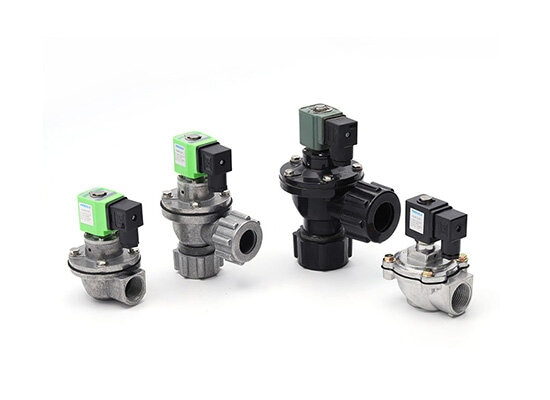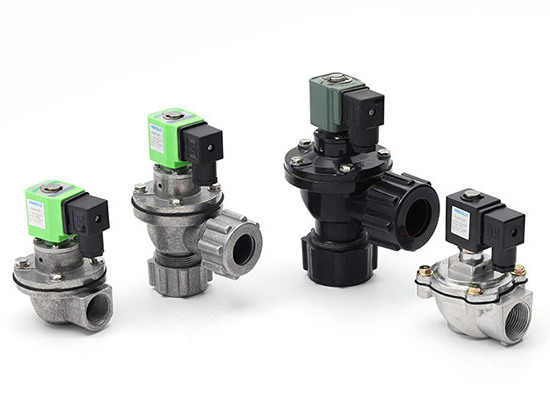
Pulse valves have efficient instantaneous blowing capabilities and are generally driven by electromagnetic, pneumatic, mechanical and other methods. They are composed of main valve body, diaphragm, control chamber, pilot mechanism and other components. Pulse solenoid valve is a type of pulse valve driven by electromagnetic force, consisting of electromagnetic coil, pilot hole, and valve core. The action is rapid, and when powered on, it instantly opens and releases gas to form a pulse drive. Pulse solenoid valves are used to control fluid or gas flow in various applications. Its working principle is to use electrical signals to control the opening and closing of valves, usually used in systems that require precise fluid control.
An electromagnetic pulse valve is a type of solenoid valve that uses an Fast electrical signals to generate an instant pulse to open or close airflow,it also can call pulse valve.
The pilot signal of a pulse valve does not remain continuously present, which confirms that a pulse valve is not a valve for regulating or controlling the pressure and direction of the fluid medium.Pulse valve is specifically designed for dust removal systems and characterized by short-duration electrical pulse control—energizing triggers immediate action, and de-energizing causes automatic reset.
Featuring a diaphragm structure,also can called diaphragm pulse solenoid jet valve.It enables rapid switching, making it suitable for high-flow, high-frequency operations. It is most commonly used in pulse-jet cleaning systems of baghouse dust collectors in environmental protection equipment.
Pulse valve features generally large-diameter, thick, and have a diaphragm structure, while pulse solenoid valves are designed to be very compact, with small valves equipped with electromagnetic heads. It often has the following advantages:
◆ Quick response and precise flow control
◆ Low power consumption
◆ High durability and reliability
◆ Compact and lightweight design
◆ Available in various sizes and configurations
◆ Can handle high-pressure systems
Pulse Solenoid Valves operate by using an electrical pulse to actuate the solenoid, which then opens or closes the valve. Its working principle shares commonality with that of a solenoid valve.
When an electrical current passes through the solenoid coil, it generates a magnetic field that moves the plunger, allowing the fluid or gas to pass through.
The pulse signal ensures the valve opens and closes at the desired intervals.
Electromagnetic Pulse Valve is a type of solenoid control valve designed to rapidly release compressed air for powerful pulse jet cleaning.Compared to a standard solenoid valve, it offers the following advantages:
Fast Response Time: Electromagnetic drive, fast response, can complete opening and closing in an instant, meeting the requirements of high-speed pulse blowing.
High Cleaning Efficiency: can instantly release a large amount of compressed air, effectively removing dust on the surface of the filter bag.
Simple and Reliable Structure: Adopting a membrane+electromagnetic coil structure, with fewer moving parts, low failure rate, and easy maintenance.
Low Energy Consumption: Due to the short duration of injection, compressed air and electricity are saved.
A pulsing solenoid valve is designed to deliver a quick, high-pressure burst of compressed air in response to a short electrical pulse.
Pulsar Jet Cleaning: Releases a sudden burst of compressed air to shake off and dislodge accumulated dust from filter surfaces.
Electromagnetic Control: Operates via a solenoid coil that triggers the valve to open with a brief electrical signal.
Energy Efficiency: Only requires power during actuation (pulse), not continuous energization.
Fast Response: Opens and closes in milliseconds for effective cleaning without wasting compressed air.
Maintains Filter Performance: Prevents clogging and ensures consistent airflow in dust collection systems.
The primary function of a Pulse Jet Valve is to control the flow of fluids or gases in automated systems. In pulse applications, it is often used in systems like dust collectors, irrigation, and HVAC to regulate the pressure and flow of air or liquids.
The VXF Series pulse valve is designed for use in high-flow and high-pressure applications, quick response and ability to handle larger volumes making it ideal for pulse application includes industrial and commercial uses.
Other types of Pulse Solenoid Valves include models designed for specific flow rates, materials, and applications, offering flexibility in industrial uses.

Pulse solenoid valve mainly used to control short bursts of high-pressure air for pulse-jet cleaning which means its Function emphasizes more complex and specialized.:
Solenoid Pulse Valves are commonly used in dust collection systems to regulate the flow of compressed air to clean dust filters.
The pulse of air helps dislodge dust and debris from filters, maintaining their efficiency and ensuring optimal air quality in industrial environments.
In water treatment plants, Solenoid Pulse Valves control the release of chemicals or regulate the flow of water during various stages of filtration and treatment.
Their precise control ensures accurate dosing and efficient treatment processes.
Solenoid Pulse Valves are used in irrigation systems to control the flow of water through irrigation lines.
They enable automatic irrigation at scheduled times, ensuring crops receive the right amount of water without manual intervention.
Solenoid Pulse Valves play a crucial role in HVAC systems, controlling the flow of air or refrigerant to regulate temperature, humidity, and air quality.
They help maintain system efficiency by precisely controlling airflow based on temperature sensors and system requirements.
In pneumatic systems, Solenoid Pulse Valves are used to control the release of compressed air, allowing for precise actuation of components such as cylinders, actuators, or tools.
They are essential for controlling airflow in automated machinery and industrial processes.
If you want to know more information of solenoid valve or pluse solenoid valve,you can directly contact us!
FOKCA ©1998-2025 All Rights Reserved Sitemap